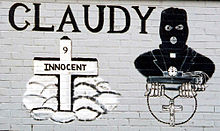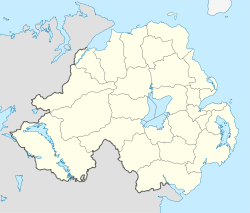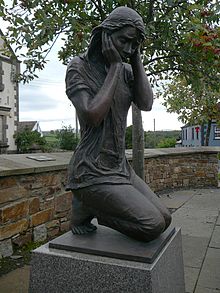- Claudy bombing
-
Claudy Bombing Part of The Troubles Location Main Street, Claudy,
Northern IrelandCoordinates 54°54′41″N 7°9′17″W / 54.91139°N 7.15472°WCoordinates: 54°54′41″N 7°9′17″W / 54.91139°N 7.15472°W Date 31 July 1972 Target Unknown Attack type Car bombings Death(s) 9 Injured 30 Suspected perpetrator(s) Provisional Irish Republican Army The Claudy bombing occurred on 31 July 1972, when three car bombs exploded mid-morning on the Main Street of Claudy in County Londonderry, Northern Ireland. The attack killed nine civilians, and became known as "Bloody Monday".[1] Those who planted the bombs had attempted to send a warning before the explosions took place. However, this warning was delayed because the telephones were out-of-order due to an earlier bomb attack.[2] The Provisional Irish Republican Army (IRA) issued an immediate denial of responsibility.[2][3] The IRA later claimed that "an internal court of inquiry" had found that its local unit did not carry out the attack.[4]
On 24 August 2010, following an eight year investigation, the Office of the Police Ombudsman for Northern Ireland (OPONI) published a report into the bombing, which concluded that Father James Chesney, a local Catholic priest, was the IRA's quartermaster and Director of Operations in the area and was directly involved in the bombings.[5] The report also stated that his role was covered up by senior police officers, government ministers and the Catholic hierarchy.[6]
Contents
Bombing
At about 4am the night before,[7] the British Army had begun Operation Motorman. This was an operation to regain control of the "no-go areas" (areas controlled by Irish republican paramilitaries) that had been established in Belfast[8] and Derry. The bombing of Claudy may have been made in response to this operation.[2]
Shortly before 10:00 am, three car bombs were placed in the centre of the village, which was busy with shoppers at the time. Initial police investigations found that a car was seen travelling from Claudy at 10:00. It had stopped at the nearby village of Feeny where a passenger tried to use the public telephone box, which was out-of-order. The car then travelled to Dungiven where it stopped on the Main Street. Two men got out and went into separate shops to use the telephones, which were also out-of-order following a bomb attack at the local telephone exchange. The men then asked the shop assistants to tell the police at Dungiven that there were three bombs in Claudy, but by this time the first bomb had already detonated.[9]
The first bomb, hidden inside a stolen Ford Cortina, exploded at 10:15 outside McElhinney’s bar and store on Main Street.[9] Six people were killed by this bomb, including an eight year old girl.[10] A second bomb, hidden inside a stolen Morris Mini Van parked outside the Post Office on Main Street,[9] was spotted by a police officer, who then began directing people away from the area towards Church Street. At 10:30, a bomb hidden inside a stolen Mini Van detonated outside the Beaufort Hotel on Church Street.[9] The bomb outside the Post Office exploded almost simultaneously, killing three people.[10]
Alleged involvement of Fr Chesney
The Derry Brigade of the Provisional Irish Republican Army (IRA) denied involvement at the time of the attack.[2] However, Derry politician Ivan Cooper (of the Social Democratic and Labour Party) claimed that the IRA and Father James Chesney (a Catholic priest from the nearby parish of Cullion) were involved in the attack. Cooper stated:
Within a couple of days, a man lurked like a scared rabbit outside one of my constituency offices. He told me the IRA was behind the bomb and I had every reason to believe him. He gave no names and I asked no names. That is the way it was then. It was dangerous to know too much. But several months later, I became aware of the identities and I have absolutely no doubt that Father Jim Chesney was involved.[2]
The type and colour of car used by those who gave the bomb warning was rare in Northern Ireland at that time. In the first week of August 1972, the RUC arrested a suspect (called "Man A") who owned a similar car. However, he provided an alibi that he had been at Chesney's home in Bellaghy at the time. Chesney and another corroborated the man's alibi and he was released after being questioned. According to the OPONI report, when Chesney was stopped at a police checkpoint in September 1972, a sniffer dog found traces of explosives in his car. The police officers involved in the original police investigation suspected the following:
- that the alibi had been prepared beforehand
- that "Man A" was an IRA member and had played a key role in the bombing
- that Chesney was the quartermaster and "director of operations" for the South Derry IRA and had also been involved in the bombing
 A loyalist mural on Lower Newtownards Road in Belfast making reference to the bombing. It shows a priest wearing a balaclava and holding a bomb.
A loyalist mural on Lower Newtownards Road in Belfast making reference to the bombing. It shows a priest wearing a balaclava and holding a bomb.
In October 1972, police intelligence alleged that Chesney had formed an "independent group of the IRA".
Some time after the bombing Chesney was questioned by the then Bishop of Derry Neil Farren, and later again by Farren's successor Bishop Edward Daly. At both times Chesney denied any involvement. Chesney served in the parish of Cullion from July 1972 until November 1972. He was then hospitalised and spent a period of recovery in County Donegal. In December 1973 he was transferred to the parish of Convoy in County Donegal. Although he often crossed the border into Northern Ireland, he was never arrested and never faced a police interview.
In 2004 a loyalist mural appeared on a wall on Lower Newtownards Road in Belfast showing a priest wearing a balaclava and holding a bomb, alongside the word "Claudy".[11]
PSNI investigation
No person was arrested for the bombings at the time but following calls for a new inquiry, a fresh investigation was started by the Police Service of Northern Ireland (PSNI) in 2002. As part of the investigation, the police uncovered documents showing that the then Secretary of State Willie Whitelaw discussed Chesney's involvement with Cardinal William Conway. The actions of two other Catholic priests, Patrick Fell and John Burns, were also examined.[12]
On 30 November 2005, the PSNI detained four people in connection with the bombing.[13] However they were released without charge the next day and deny involvement.[14] Among those arrested was the then Sinn Féin MLA Francie Brolly,[15] who subsequtnly secured an out-of-court settlement in a legal action against the police.
Police Ombudsman Report
On 24 August 2010, the Police Ombudsman for Northern Ireland published a report into the bombing which concluded that the British Government and the Catholic Church had conspired to cover-up Chesney's alleged involvement.[16] The report stated:
The arrest of a priest in connection with such an emotive atrocity at a time when sectarian killings in Northern Ireland were out of control and the province stood on the brink of civil war was feared, by senior politicians, as likely to destabilise the security situation even further. A deal was therefore arranged behind closed doors to remove Fr Chesney from the province without provoking sectarian fury.[16]
According to the report by Al Hutchinson, the Northern Ireland Police Ombudsman,
The RUC's decision to ask the government to resolve the matter with the Church and then accept the outcome, was wrong. The decision failed those who were murdered, injured and bereaved in the bombing. The police officers who were working on the investigation were also undermined. I accept that 1972 was one of the worst years of the Troubles and that the arrest of a priest might well have aggravated the security situation. Equally, I consider that the police failure to investigate someone they suspected of involvement in acts of terrorism could, in itself, have had serious consequences.[17]
The report found the following:
- Detectives believed Father Chesney was the IRA's director of operations in southern County Londonderry and was a prime suspect in the Claudy attack and other paramilitary incidents.[17]
- A detective's request to arrest Chesney was refused by an Assistant Chief Constable of RUC Special Branch who instead said that "matters are in hand".[17]
- The same senior officer wrote to the government about what action could be taken to "render harmless a dangerous priest" and asked if the matter could be raised with the Church's hierarchy.[17]
- In December 1972, Willie Whitelaw met the head of the Catholic Church in Ireland, Cardinal William Conway, to discuss the issue. According to a Northern Ireland Office official "the Cardinal said he knew the priest was 'a very bad man' and would see what could be done". The church leader mentioned "the possibility of transferring him to Donegal". In response to this memo, RUC Chief Constable Sir Graham Shillington noted: "I would prefer transfer to Tipperary."[17]
- An entry in Cardinal Conway's diary on 4 December 1972 confirmed that a meeting with Mr Whitelaw had taken place and stated that there had been "a rather disturbing tete-a-tete at the end about C".[17]
- In another diary entry two months later, the Cardinal noted that he had discussed the issue with Father Chesney's superior and that the superior "had given him orders to stay where he was, on sick leave, until further notice".[17]
Mr Whitelaw died in 1999, Cardinal Conway in 1977, Sir Graham in 2001 and Father Chesney (aged 46) in 1980.[17]
Memorial
A memorial to those killed and injured by the bombing was erected on Claudy's Main Street in 2000, consisting of a bronze figure of a kneeling girl, created by sculptor Elizabeth McLaughlin, mounted on a stone plinth. A number of plaques commemorating the victims are affixed to the wall enclosing the statue.[18] The statue was damaged on 20 October 2006 when vandals knocked it from the plinth.[19]
References
- ^ "Priest played central role in atrocity, says SDLP founder". Irish Independent. 21 September 2002. http://www.independent.ie/national-news/priest-played-central-role-in-atrocity-says-sdlp--founder-293648.html. Retrieved 24 August 2010.
- ^ a b c d e Cowan, Rosie (21 September 2002). "Does this letter prove a priest was behind IRA bombing?". The Guardian. http://www.guardian.co.uk/Northern_Ireland/Story/0,2763,796304,00.html.
- ^ Starrett, Ian (30 July 1997). "When the heart was ripped out of Claudy". News Letter. http://www.highbeam.com/doc/1P2-10669652.html. Retrieved 24 August 2010. Archived article at HighBeam Research
- ^ Tran, Mark (24 August 2010). "Report due on claims of Claudy bombing priest link". The Guardian. http://www.guardian.co.uk/uk/2010/aug/24/report-claudy-bombing-priest-chesney. Retrieved 24 August 2010.
- ^ Simpson, Mark (24 August 2010). "Claudy bomb: A priest who got away with murder". BBC News. http://www.bbc.co.uk/news/uk-northern-ireland-11071321. Retrieved 24 August 2010.
- ^ Bowcott, Owen (24 August 2010). "Claudy bombings cover-up revealed in police report". The Guardian. http://www.guardian.co.uk/uk/2010/aug/24/claudy-bombings-cover-up-report. Retrieved 24 August 2010.
- ^ Joe McAllister. "History – Operation Motorman". Museum of Free Derry. http://www.museumoffreederry.org/history-motorman.html. Retrieved 27 September 2010.
- ^ "Operation Motorman soldiers 'not traced'". UTV News. 22 March 2010. http://www.u.tv/News/Operation-Motorman-soldiers-not-traced/863ca373-809a-48eb-a92b-30f39cbe6fe1. Retrieved 27 September 2010.
- ^ a b c d Public statement by the Police Ombudsman under section 62 of the Police (NI) Act 1998 Police Ombudsman for Northern Ireland, 24 August 2010
- ^ a b "The victims of the Claudy bombing". BBC News. 24 August 2010. http://www.bbc.co.uk/news/uk-northern-ireland-11026426. Retrieved 24 August 2010.
- ^ Dr Jonathan McCormick (27 April 2010). "A Directory of Murals - Album 64". CAIN. University of Ulster. http://cain.ulst.ac.uk/mccormick/album64.htm#no2247. Retrieved 24 August 2010.
- ^ McDonald, Henry (22 December 2002). "Three more IRA priests in Claudy link". The Guardian. http://www.guardian.co.uk/uk/2002/dec/22/northernireland.
- ^ "Four still held on 1972 bombings". BBC News. 30 November 2005. http://news.bbc.co.uk/1/hi/northern_ireland/4480980.stm.
- ^ "Police preparing 1972 bomb report". BBC News. 1 December 2005. http://news.bbc.co.uk/1/hi/northern_ireland/4488322.stm.
- ^ "Four released in Claudy bombing probe". RTE News. 1 December 2005. http://www.rte.ie/news/2005/1201/claudy.html.
- ^ a b Gabbatt, Adam (24 August 2010). "Claudy bombing report released - live updates". The Guardian. http://www.guardian.co.uk/uk/blog/2010/aug/24/claudy-bombing-report-priest-northern-ireland. Retrieved 24 August 2010.
- ^ a b c d e f g h "Claudy bombing: priest's role in IRA attack 'was covered up'". Daily Telegraph. 24 August 2010. http://www.telegraph.co.uk/news/uknews/northernireland/7961648/Claudy-bombing-priests-role-in-IRA-attack-was-covered-up.html. Retrieved 24 August 2010.
- ^ "Memorial marks 'forgotten' atrocity". BBC News. 20 August 2000. http://news.bbc.co.uk/1/hi/northern_ireland/888643.stm. Retrieved 27 September 2010.
- ^ "Mayor Condemns Claudy Vandals". Derry City Council. 23 October 2006. http://www.derrycity.gov.uk/Press%20Releases/231006-claudy.htm. Retrieved 24 August 2010.
External links
- Claudy Report Police Ombudsman for Northern Ireland, 24 August 2010
- Anderson, Bruce "Sometimes justice can best be done by not enforcing the criminal law" The Independent, 23 December 2002
- Claudy in focus after atrocity was forgotten for 25 years Irish News Article on the bombing, 1 December 2005
- A Chronology of the Conflict - 1972 CAIN (Conflict Archive on the INternet) project in context and A Chronology of the Conflict - 1997 1997 CAIN claims
The Troubles Participants in the Troubles Chronology Political Parties Republican
paramilitariesSecurity forces of the United Kingdom
Loyalist
paramilitaries• Ulster Defence Association
• Ulster Volunteer Force
• Loyalist Volunteer Force
• Red Hand Commandos
• Young Citizen Volunteers
• Ulster Young Militants
• Ulster Resistance
• UVF Mid-Ulster Brigade
Linked to
• Some RUC and British Army members• Northern Ireland Civil Rights Association formed (1967)
• Battle of the Bogside (1969)
• Riots across Northern Ireland (1969)
• Beginning of Operation Banner (1969)
• Social Democratic and Labour Party formed (1970)
• Internment without trial begins with Operation Demetrius (1971)
• Bloody Sunday by British Army (1972)
• Northern Ireland government dissolved. Direct rule from London begins (1972)
• Bloody Friday by Provisional IRA (1972)
• Power sharing Northern Ireland Assembly set up with SDLP and Ulster Unionist Party in power (1973)
• Mountjoy Prison helicopter escape. Three Provisional IRA prisoners escape from Mountjoy Prison by helicopter (1973)
• Ulster Workers' Council strike causes power-sharing Northern Ireland Assembly to end (1974)
• Dublin and Monaghan bombings by UVF with alleged British Army assistance (1974)
• Kingsmill massacre by South Armagh Republican Action Force (1976)
• Warrenpoint Ambush by Provisional IRA (1979)
• 1981 Irish hunger strike by Provisional IRA and INLA members (1981)
• Hunger striker Bobby Sands elected MP. Marks turning point as Sinn Féin begins to move towards electoral politics (1981)
• Maze Prison escape. 38 Provisional IRA prisoners escape from H-Block 7 of HM Prison Maze (1983)
• Brighton hotel bombing by Provisional IRA (1984)
• Anglo-Irish Agreement between British and Irish governments (1985)
• Remembrance Day bombing by Provisional IRA (1987)
• Peace Process begins (1988)
• Operation Flavius, Milltown Cemetery attack and Corporals killings (1988)
• Bishopsgate bombing (1993)
• Downing Street Declaration (1993)
• First Provisional IRA ceasefire (1994)
• Loyalist ceasefire (1994)
• Docklands bombing (1996)
• 1996 Manchester bombing (1996)
• Second Provisional IRA ceasefire (1997)
• Good Friday Agreement (1998) signals the end of the Troubles
• Assembly elections held, with SDLP and UUP winning most seats (1998)
• Omagh bombing by dissident Real IRA (1998)• Unionist parties:
• Democratic Unionist Party
• Northern Ireland Unionist Party
• Ulster Unionist Party
• Progressive Unionist Party
• Conservative Party
• UK Unionist Party
• Traditional Unionist Voice
• Nationalist parties:
• Democratic Left
• Fianna Fáil
• Fine Gael
• Labour Party
• Progressive Democrats
• Sinn Féin
• Social Democratic & Labour Party
• Workers' Party of Ireland
• Irish Republican Socialist Party
• Republican Sinn Féin
• Cross-community parties:
• Alliance Party
• Historically important parties:
• Nationalist Party
• Northern Ireland Labour Party
• Protestant Unionist Party
• Vanguard Unionist Progressive Party
• Northern Ireland Women's Coalition
• People's Democracy
• Republican Labour Party
• Anti H-Block
• Irish Independence Party The Troubles at Wiktionary ·
The Troubles at Wiktionary ·  The Troubles at Wikibooks ·
The Troubles at Wikibooks ·  The Troubles at Wikiquote ·
The Troubles at Wikiquote ·  The Troubles at Wikisource ·
The Troubles at Wikisource ·  The Troubles at Commons ·
The Troubles at Commons ·  The Troubles at WikinewsCategories:
The Troubles at WikinewsCategories:- The Troubles in County Londonderry
- 1972 in Northern Ireland
- Car and truck bombings in the United Kingdom
- Terrorism in Northern Ireland
- Religious scandals
Wikimedia Foundation. 2010.


